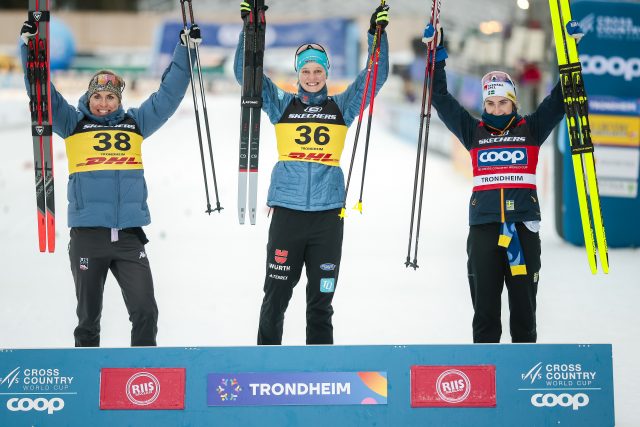 This coverage is made possible through the generous support of Marty and Kathy Hall and A Hall Mark of Excellence Award. To learn more about A Hall Mark of Excellence Award, or to learn how you can support FasterSkier’s coverage, please contact info@fasterskier.com.
This coverage is made possible through the generous support of Marty and Kathy Hall and A Hall Mark of Excellence Award. To learn more about A Hall Mark of Excellence Award, or to learn how you can support FasterSkier’s coverage, please contact info@fasterskier.com.
Today wrapped up three days of racing in Trondheim, Norway, where the 10 k Classic individual start race was contested this morning. The “10 k” race name was a bit of a misnomer, as the actual distance raced was 11 kilometers. The American women have set a blistering pace this season: Rosie Brennan finished second in this event three weeks ago in Ruka. Jessie Diggins’ Classic skiing this year has looked especially crisp. So, hopes were high for the American squad.
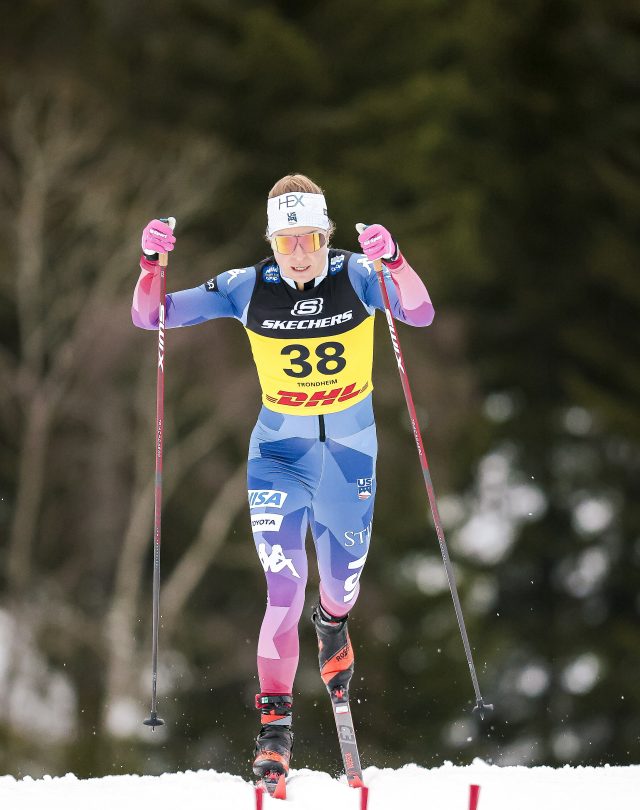
Standing in their way were the ever-present Swedish women: Ebba Andersson (SWE) took first in the same race where Brennan had finished second, and Frida Karlsson (SWE) was nipping on Brennan’s heels in that race. But Karlsson was a last minute DNS on Sunday in Trondheim, and was substituted with Johanna Hagstroem. Naturally, whenever there’s a Classic race of some distance, oddsmakers will factor in Kerttu Niskanen (FIN); the Classic expert has won all of her five individual World Cup victories in 10 k Classic Individual Start races!
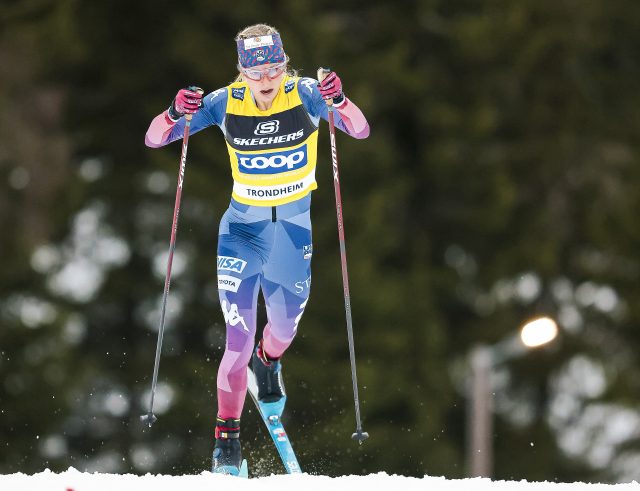
In another warm day in Trondheim—temperatures in the mid-30s and Classic tracks glazed—it was Victoria Carl (GER) taking the win and making German history. Brennan repeated her second place Classic performance, and Ebba Andersson (SWE) came in third.
Jessie Diggins missed the podium by seven seconds, finishing fourth. Other American finishers were Novie McCabe, 25th and Alayna Sonnesyn, 48th. Sophia Laukli missed the weekend of racing due to illness.
The top Canadian was Katherine Stewart-Jones in a very impressive 18th. The other Canadian finisher was Amelia Wells in 51st.
Women’s 10 k Classic Interval Start
Warm conditions meant that it was another klister day for skiers. Under the new fluoro rules, in individual start races competitors need to have their skis turned in 30 minutes before their start time: another change to which skiers and technicians are being forced to adapt. “Later starters don’t have access to the race course for testing with their technicians,” U.S. coach Chris Grover told FasterSkier. “When the race starts they close the course—and with conditions like we have now—that means there’s almost no other skiing available, so the tests that you’ve done are earlier on.” Conditions with the warm weather were variable. Grover described it as “sugary with ice underneath, with glazing tracks.”
Rosie Brennan (USA) had a relatively low bib number for the seeded athletes which made her one of the early pre-race favorites to go through time checks. Niskanen started shortly behind her. Diggins was in an excellent starting position, getting bib number 56 with only a handful of serious contenders starting behind her. Diggins has said in the past that she doesn’t usually listen to split times during the race but, with today’s lineup, she would be able to hear reports of the progress of most of her competition ahead of her. The crowd gave Diggins an enthusiastic cheer to send her off.
Early on, Astrid Oeyre Slind (NOR) set the standard with the fastest time at the two kilometer mark. But Carl (GER) quickly supplanted her taking a nine second lead. Carl has been skiing well; she had her first World Cup podium last week and had extra motivation today. No German—East, West, or Unified; male or female—has ever won a World Cup 10 k Classic individual start race. That was about to change . . .
Brennan was only two skiers behind Carl and would be able to chase her throughout the day. Brennan was third when she went through the two kilometer mark but, as other skiers came through, she dropped to fourth. As the seeded skiers continued to pass the two kilometer mark, Carl’s time continued to hold. When Diggins passed the timing mark, she was in fourth, and after the rest of the pack went through, she had dropped to sixth.
Carl continued to set the standard as she progressed to the 3.4 kilometer mark. As the top skiers passed through, Carl’s mark was still unmatched. But the question lingered as to whether she had gone out too hard?
Slind then put in a turn of pace and moved into second only three-tenths of a kilometer later. It was already a pitched battle for second and third but, shockingly, no one was putting a dent into Carl’s lead.
Carl’s lower start number meant that she would finish ahead of most of the other skiers in contention. When she crossed the finish line, she had a whopping 47 second advantage over the skiers who had already finished. It was a massive margin that seemed untouchable, but most of the top contenders were still on course. Brennan, Diggins, Andersson, and Slind were still lurking.
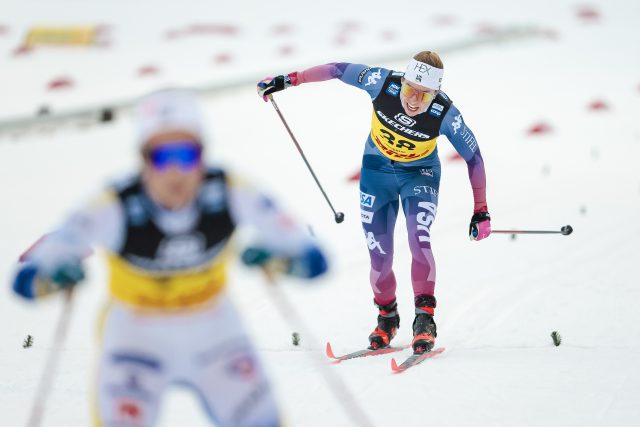
One by one, the top-ranked skiers crossed the finish. One by one, they each fell short of Carl. They were gut-wrenching moments for the German as she stared on in disbelief while her time continued to hold. When Brennan came through the finish, she was 19.6 seconds behind Carl, in second place, but several of the top skiers were still on course.
Niskanen finished after Brennan, but she never really factored into the leaders’ chase today. She was third as she crossed the finish line, but it was clear that her time wouldn’t hold up. She ended up fifth.
Andersson seemed to have one of the best chances to top Carl. But as she came into the stadium her pace began to lag, and the clock told the story that, for the time being, Carl remained safe. Andersson pushed hard in the last several meters but couldn’t displace Carl. Andersson’s time was good enough for third, 21.6 seconds behind Carl, and only two seconds behind Brennan, who remained in second.
Now it was Diggins’ turn to see if she could dislodge Carl. At the 8.9 kilometer mark she was in third, 20 seconds off the lead, and at 9.8 k she had drifted to 23 seconds back. It was clear before she entered the stadium that Diggins would not be able to match Carl’s time. Diggins turned in a final burst trying to find the podium but crossed the line fourth. She was seven seconds behind Andersson, and 28 seconds away from Carl.
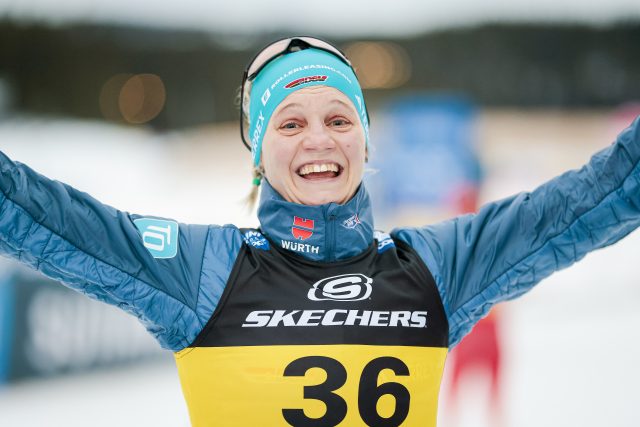
Carl shook her head as she saw finisher after finisher unable to match her time. After Diggins crossed the line, Carl’s victory was secured. She cried in disbelief as she not only found her first World Cup victory but made history for Germany.
After the race Carl commented that she started a little slowly to save energy. She said her first World Cup victory was unbelievable. “It was crazy!'” she beamed. “The whole team is on fire, we had very good skis.” It was clearly an emotional moment for Carl who finally found victory after 138 World Cup starts.
Another Classic podium held special meaning for Brennan. “Getting another Classic podium is great,” She told FasterSkier. “It’s reassuring that my Classic is good, that [the prior podium] wasn’t a fluke. I’m feeling really strong in Classic. I felt like if I pushed like I did yesterday, there would be a good chance at a podium.”
Even though Brennan got faster as the race went on, it wasn’t a tactic. “I didn’t intentionally increase my pace,” Brennan said. “I tried to start very hard, but I’m just not good at starting hard. Sometimes it takes me a little to get going, and find a relaxed state to get the most out of my skiing.”
Like Brennan, Diggins turn of speed in the second half of the race was not strategic. She said, “I think certain sections of the course suited me better. The sections where you had to herringbone in sugar were challenging for me; that’s still a technique that I’m really working on. That’s probably my biggest weakness. So I tried to really hammer the sections where I was able to.”
The tricky conditions were challenging, but the Americans seemed happy with their skis. “The service team absolutely hit it out of the park today,” Grover told FasterSkier. “They figured it out … the kick, the glide, the structure, we had really good skis all day.” Brennan concurred: “My skis were pretty good,” she said. “When I started I had some slips and kind of panicked, but I think that was me just not skiing my best. When I found my groove and my rhythm, I felt great. I love klister skiing”
For Diggins, today was a new strategy for kick wax. She said, “I’ve been working on having the confidence to not ask for an additional kick wax bump. Yesterday I did, and that might have been part of why my glide was so slow on the Classic side. So today, I was … all right, I’m going to ski with confidence, if this blows up in my face, at least I tried something different. In testing the skis were good and I’m going to assume they are going to stay good, and they did! I was really impressed with our skis”
American skiers once had to deal with the label of being primarily Skaters; that’s no longer the case. Grover said, “Both [Brennan and Diggins] have made really nice improvements in their Classic technique”. He continued that, “Rosie and Jessie have put in a lot of time on the technique, and it’s paid off already. There have been a lot of comments trickling back to us that both those athletes have made a lot of adjustments … noticing the improvements they’ve both made.”
Another point of pride for team USA which Grover pointed out, was that the Americans are in third place in the Nations Cup standings. Another huge achievement for the U.S. as they currently hold a lead over Finland, Germany, and France.
Women’s 10 k Classic Interval Start RESULTS
